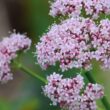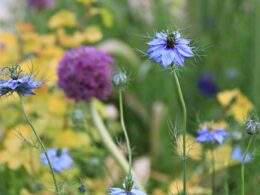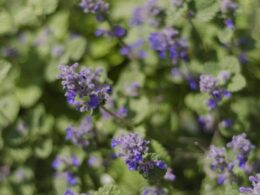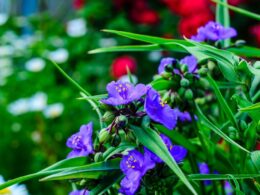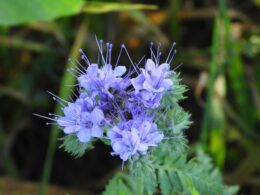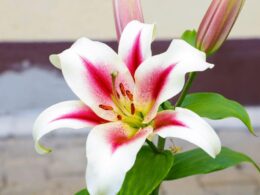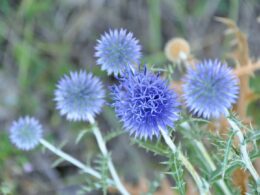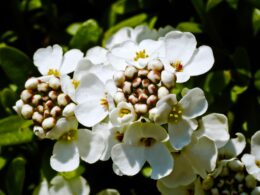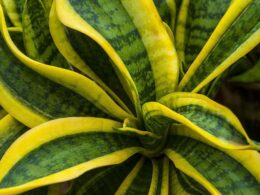About Sedum Plants (Stonecrop) – Species and Origin
Sedum is a genus of hardy, drought-tolerant succulents that are native to Europe and Asia. They have fleshy leaves that store water, and its stems are covered in small, star-shaped flowers. Sedums are commonly grown as houseplants or in rock gardens, and they require very little care. Many cultivars are hybrids, but some notable sedum flower species are:
- Sedum telephium – commonly known as orpine, livelong or harping Johnny;
- Sedum reflexum – known as reflexed stonecrop, stone orpine and trip-madam;
- Sedum acre – often called goldmoss stonecrop, mossy stonecrop or wallpepper.
Sedums vary from annual to perennial, with some being creeping herbs and others being shrubs. They can add a range of colors to your garden, including pink, purple, burgundy, rose, and blue. The bloom time also depends on the variety. More on that below!
Sedum Flower Varieties and Their Bloom Times
There are sedums for almost every season and climate. They’re one of the longest-blooming perennials, with some varieties flowering from summer to fall. Here are some popular sedum flower cultivars, their colors and bloom times.
- ‘Autumn Charm’ – gray and yellow variegated leaves plus pink flowers appearing in early fall.
- ‘Beach Party’ – light rose-pink flowers opening up in late summer.
- ‘Chocolate Drop’ – burgundy foliage plus light pink and ruby flowers, blooming in mid to late summer.
- ‘Desert Red’ – deep rose-pink flowers that bloom in mid to late summer, then turn cherry-red by fall.
- ‘Blue Pearl’ – blue-gray leaves with clusters of pink flowers from summer to fall.
- ‘Angelina’ – needle-like, bright yellow leaves that turn orange in fall; fragrant, lemon-yellow flowers bloom in late summer.
As you can see, sedums come in a range of colors, and they can brighten up your garden from summer to fall. Now that you know a little more about sedums, let’s discuss how to care for them.
How to Care for Sedum Plants
Sedums are low-maintenance plants that are easy to care for. They can be propagated from stem cuttings or seeds, and they’re tolerant of a range of soils, including clay, sand, and loam. They prefer full sun but can tolerate light shade, and they’re drought-tolerant once established.
To care for sedums, water them deeply about once a week during the growing season. Allow the soil to dry out between watering to prevent root rot. Fertilize sedums once a year with a thin layer of compost or a handful of slow-release pellets.
Cut back the stems by about half their length in early spring to encourage new growth. You can use the cuttings to propagate new plants. Here’s how to do it:
- Take a 6-inch cutting from a healthy stem in early spring.
- Remove the lower leaves and dip the cut end in rooting hormone powder (this is optional).
- Plant the cutting in damp, well-draining potting mix.
- Place it in bright, indirect light.
- After 2-3 weeks, gently tug on the cutting. If it resists, that means it’s rooted.
Sedums are generally pest- and disease-free, but they can be susceptible to mealybugs, aphids, and ants. Watch for these pests and treat them with an insecticidal soap or neem oil if necessary.
Overwintering Sedum Plants
If you live in a cold climate, you’ll need to take some precautions to overwinter sedum plants. Bring potted sedums indoors or cover them with a layer of mulch before the first frost. Cut back the stems, and water them only enough to keep the leaves from wilting.
You can also grow sedums as annuals in very cold climates. Start them indoors in late winter or early spring, and transplant them outside after the last frost.
Whether you grow sedum flowers as annuals or perennials, they’re sure to add color and interest to your garden. With their low-maintenance needs and long bloom times, sedums are a great choice for beginning gardeners or those with little time to spare.
Where Can You Get Sedum Flowers?
If you’re looking to add sedum flowers to your garden, you can find them at most nurseries and garden centers. You can also order them online from a number of sources. Keep in mind that the available cultivars will vary depending on your location.
Now that you know all about sedums, why not give them a try in your own garden? With their colorful blooms and easy-care needs, they’re sure to brighten up any space. Happy gardening!






